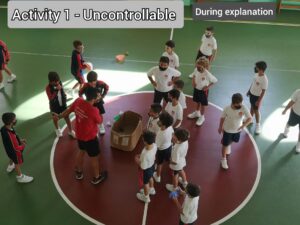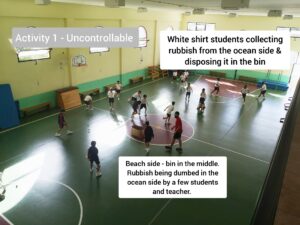BeMED 5. Uncontrollable
Title |
UncontrollableActivity 1 of 3 about plastic pollution |
Author |
Saviour Bonnici |
Age Guide |
Year 1-8 |
Subject Area |
Physical Education |
| Preparation Time | 3 minutes |
| Estimated Duration | 30 to 45 minutes |
| Site | Gym/ Yard / Outdoor space |
| No. of participants | Whole class |
| Educational objectives | Students will learn about the negative impacts of using a lot of plastic while engaging in physical activity. Learning while moving, and having fun, greatly improves the long-term memory of the learnt material.
Students will understand that less plastic = healthier oceans = healthier fish, Earth and humans. Students will acknowledge that as long as humans continue to use huge amounts of plastic, the waste problem continues to be uncontrollable – it is up to us to reduce the consumption. Students will realise how wind and storms aggravate the plastic pollution in the sea. |
| Learning Outcomes | – I am able to throw an implement from a standing and moving position using the correct technique (alternate limbs) and correct grip.
– I can identify the root causes of injustice (plastic rubbish) and can take actions that lead to a better quality of life and environmental sustainability. – I understand that I am responsible for my actions and capable of anticipating the problems of consuming plastic and adapt to reduce it. – I can involve myself and others (family and friends) in real-world issues (plastic rubbish) to bring about a positive difference (reduce single-use plastic consumption). – I am now equipped with a future-oriented perspective for how I live my life as a citizen in my country and in the world. |
| Link to SDGs
|
SDG 12: Responsible consumption
SDG 14: Life below water SDG 15: Life on Land |
| Equipment needed | The teacher will need to mark the areas (diagram below) by either:
1) Mark the midline and rubbish bin area with markers or cones. OR 2) If equipment isn’t available improvise by using either 2 chairs or 2 bottles to mark the midline peripheries. Same goes for the rubbish bin area. The teacher will also need safe throwable material by either using: 1) Bibs, markers and/or soft balls (at least 10 pieces but the more the better) OR 2) If this is not available any other plastic material such as plastic bottles, caps & wrapping. Internet connection is needed to watch the video links provided in the background information.
|
| Safety Precautions
|
Use soft objects to throw that do not have a sharp edge – markers and softballs are great. |
| Method | Objective: The team with least amount of plastic before time expires wins the game.
Part 1: Introducing Plastic in the Sea The game 1. Playing area is divided in 2 sections (diagram above) – Beach and Sea. 2. The Beach is occupied by the Teacher and 2 other students. These are the bad guys. The rest of the students are on the ‘Sea’ area – the good guys.
3. The bad guys have a few markers/bibs/ or any other type of safe throwable equipment – representing the plastic. They will be throwing the plastic in the sea. It is important to use only a few of the equipment for this introductory part.
4. The good guys need to remove all the plastic that falls in the sea area and put it in the ‘Rubbish Bin’ area (see diagram). The team with the least amount of plastic in its area after time expires (decided beforehand) wins the game. Part 2: The plastic problem grows bigger – Uncontrollable Same organization as in 1st part, but the equipment (plastic material) starts increasing until the good guys cannot keep up with the rubbish thrown in the sea. Part 3: The Wind factor Five other students representing the ‘Wind’ join the three bad guys. The ‘Wind’ help the bad guys throw the plastic in the sea and therefore showcase how the plastic problem is truly uncontrollable.
|
| Recap
|
When the game is over the teacher explains about our negative impacts related to the sea pollution and how the problem is nowadays uncontrollable because there is too much plastic.
Video 1 below clearly explains these negative impacts. Furthermore, the issue is aggravated by the wind, which blows rubbish in the sea even when rubbish is disposed of properly. The real practical solution is to reduce our plastic consumption. Questions for students: Why is plastic bad? Natural materials decompose and are naturally recycled. Plastic is an artificial material that humans invented which no living creature is used to, thus causing great harm to many animals and the Earth. It takes very long to decompose and accumulates in huge amounts. What are the solutions to reducing plastics? Nowadays it is very difficult to eliminate plastic, but reusing materials, fixing, finding natural alternatives, and eventually recycling them are some of the solutions. |
| Follow-up activities | Next step is for students to experience the negative impacts of plastic by playing the next 2 follow-up lessons – Plastic Breakdown and Accumulation. These complete a series of physically active lessons about plastic pollution. |
| Background information for educators | Video 1: What really happens to the plastic you throw away – Emma Bryce
https://www.youtube.com/watch?v=_6xlNyWPpB8 (Suitable for students of all ages.) Video 2: Plastic Pollution: How Humans are turning the World into Plastic https://www.youtube.com/watch?v=RS7IzU2VJIQ (Can be used with older students to get in-depth about the plastic issue.) The UN links below are a great source to learn more about plastic problems: SDG 12 – Responsible consumption: https://www.un.org/sustainabledevelopment/sustainable-consumption-production/ SDG 14 – Life below water: |







